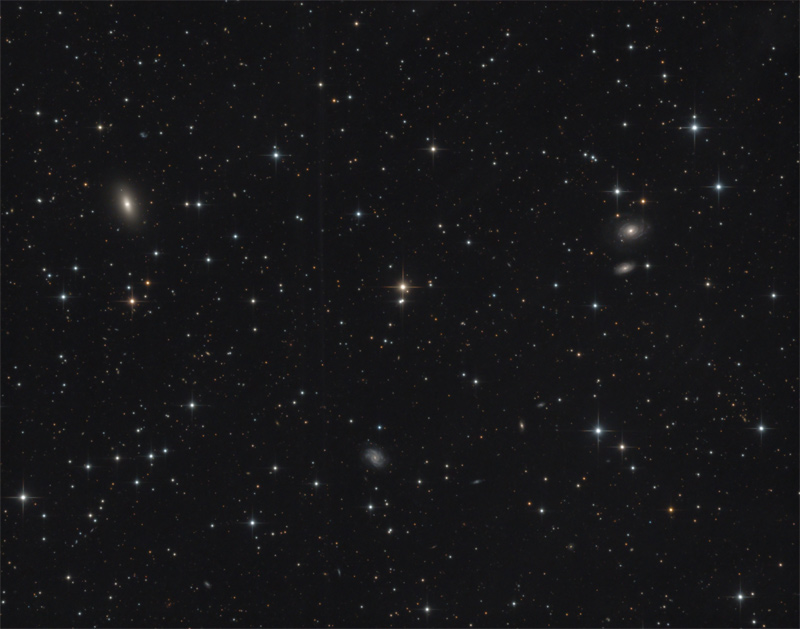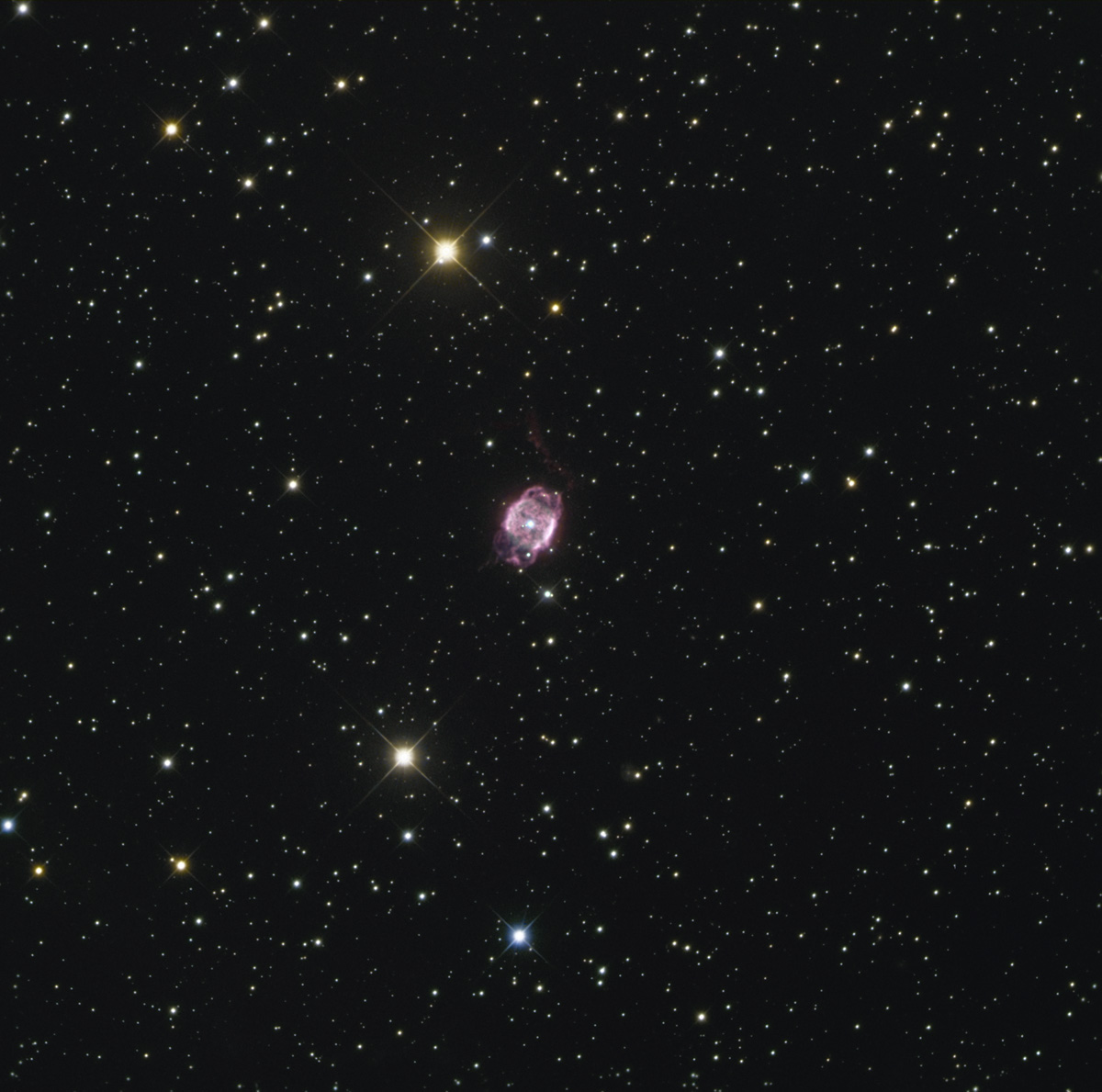Found Images: 2018 May
-
starsurfer
- Stellar Cartographer
- Posts: 5409
- Joined: Thu Mar 15, 2012 7:25 pm
-
starsurfer
- Stellar Cartographer
- Posts: 5409
- Joined: Thu Mar 15, 2012 7:25 pm
ESO: VIMOS’s Last Embrace
VIMOS’s Last Embrace
ESO Picture of the Week | 2018 May 21
ESO Picture of the Week | 2018 May 21
Two spiral galaxies are locked in a spellbinding, swirling dance in this image from the VIMOS instrument on ESO’s Very Large Telescope (VLT). The two interacting galaxies — NGC 5426 and NGC 5427 — together form an intriguing astronomical object named Arp 271, the subject of this, the final image captured by VIMOS before it was decommissioned on 24 March 2018.
VIMOS — or, in full, the VIsible Multi-Object Spectrograph — was active on the VLT for an impressive 16 years. During that time it helped scientists to uncover the wild early lives of massive galaxies, observe awe-inspiring triple-galaxy interactions, and explore deep cosmic questions such as how the Universe’s most massive galaxies grew so large. Instead of focusing on single objects, VIMOS was able to capture detailed information about hundreds of galaxies at once. This sensitive instrument collected the spectra of tens of thousands of galaxies throughout the Universe, showing how they formed, grew, and evolved.
Arp 271 is framed against a backdrop of distant galaxies in this view, and wisps of bluish gas, dust and young stars can be seen bridging the gap between the two galaxies — a result of their mutual gravitational interaction. Like many astronomical observations, this image looks back in time. Thanks to the vast gulf of space separating the Earth and Arp 271, this image shows how the galaxies looked over 110 million years ago: the amount of time it has taken their light to reach us. This kind of collision and merger is also thought to be the eventual fate of the Milky Way, which scientists believe will undergo a similar interaction with our neighbouring galaxy Andromeda.
Know the quiet place within your heart and touch the rainbow of possibility; be
alive to the gentle breeze of communication, and please stop being such a jerk. — Garrison Keillor
alive to the gentle breeze of communication, and please stop being such a jerk. — Garrison Keillor
HEIC: Between Local and Laniakea
Between Local and Laniakea
ESA Hubble Picture of the Week | 2018 May 21
ESA Hubble Picture of the Week | 2018 May 21
At first glance, this image is dominated by the vibrant glow of the swirling spiral to the lower left of the frame. However, this galaxy is far from the most interesting spectacle here — behind it sits a galaxy cluster.
Galaxies are not randomly distributed in space; they swarm together, gathered up by the unyielding hand of gravity, to form groups and clusters. The Milky Way is a member of the Local Group, which is part of the Virgo Cluster, which in turn is part of the 100 000-galaxy-strong Laniakea Supercluster.
The galaxy cluster seen in this image is known as SDSS J0333+0651. Clusters such as this can help astronomers understand the distant — and therefore early — Universe. SDSS J0333+0651 was imaged as part of a study of star formation in far-flung galaxies. Star-forming regions are typically not very large, stretching out for a few hundred light-years at most, so it is difficult for telescopes to resolve them at a distance. Even using its most sensitive and highest-resolution cameras, Hubble cannot resolve very distant star-forming regions, so astronomers use a cosmic trick: they search instead for galaxy clusters, which have a gravitational influence so immense that they warp the spacetime around them. This distortion acts like a lens, magnifying the light of galaxies sitting far behind the cluster and producing elongated arcs like the one seen to the left of centre in this image.
Know the quiet place within your heart and touch the rainbow of possibility; be
alive to the gentle breeze of communication, and please stop being such a jerk. — Garrison Keillor
alive to the gentle breeze of communication, and please stop being such a jerk. — Garrison Keillor
-
starsurfer
- Stellar Cartographer
- Posts: 5409
- Joined: Thu Mar 15, 2012 7:25 pm
Re: Found Images: 2018 May
Crescent Nebula (NGC 6888) and Soap Bubble Nebula
https://www.flickr.com/photos/avdhoeven/34185257516/
Copyright: Andre van der Hoeven
https://www.flickr.com/photos/avdhoeven/34185257516/
Copyright: Andre van der Hoeven
-
starsurfer
- Stellar Cartographer
- Posts: 5409
- Joined: Thu Mar 15, 2012 7:25 pm
-
starsurfer
- Stellar Cartographer
- Posts: 5409
- Joined: Thu Mar 15, 2012 7:25 pm
-
starsurfer
- Stellar Cartographer
- Posts: 5409
- Joined: Thu Mar 15, 2012 7:25 pm
-
starsurfer
- Stellar Cartographer
- Posts: 5409
- Joined: Thu Mar 15, 2012 7:25 pm
Re: Found Images: 2018 May
NGC 40
http://www.capella-observatory.com/Imag ... /NGC40.htm
Copyright: Stefan Binnewies, Rainer Sparenberg and Josef Pöpsel
http://www.capella-observatory.com/Imag ... /NGC40.htm
Copyright: Stefan Binnewies, Rainer Sparenberg and Josef Pöpsel
-
starsurfer
- Stellar Cartographer
- Posts: 5409
- Joined: Thu Mar 15, 2012 7:25 pm
-
starsurfer
- Stellar Cartographer
- Posts: 5409
- Joined: Thu Mar 15, 2012 7:25 pm
Re: Found Images: 2018 May
NGC 5090-1
http://www.chart32.de/index.php/component/k2/item/134
Copyright: CHART32
Processing: Bernd Flach-Wilken
http://www.chart32.de/index.php/component/k2/item/134
Copyright: CHART32
Processing: Bernd Flach-Wilken
ESO: Hidden from View (NGC 5643)
Hidden from View
ESO Picture of the Week | MUSE | ALMA | 2018 May 28
Resolving the nuclear obscuring disk in the Compton-thick Seyfert galaxy NGC5643 with ALMA - A. Alonso-Herrero et al
ESO Picture of the Week | MUSE | ALMA | 2018 May 28
This ESO Picture of the Week shows the centre of a galaxy named NGC 5643. This galaxy is located 55 million light-years from Earth in the constellation of Lupus (The Wolf), and is known as a Seyfert galaxy. Seyfert galaxies have very luminous centres — thought to be powered by material being accreted onto a supermassive black hole lurking within — that can also be shrouded and obscured by clouds of dust and intergalactic material.
As a result, it can be difficult to observe the active centre of a Seyfert galaxy. NGC 5643 poses a further challenge; it is viewed at a high inclination, making it even trickier to view its inner workings. However, scientists have used the Atacama Large Millimeter/submillimeter Array (ALMA) together with archival data from the Multi Unit Spectroscopic Explorer (MUSE) instrument on ESO’s Very Large Telescope to reveal this view of NGC 5643 — complete with energetic outflowing ionised gas pouring out into space.
These impressive outflows stretch out on either side of the galaxy, and are caused by matter being ejected from the accretion disc of the supermassive black hole at NGC 5643’s core. Combined, the ALMA and VLT data show the galaxy’s central region to have two distinct components: a spiraling, rotating disc (visible in red) consisting of cold molecular gas traced by carbon monoxide, and the outflowing gas, traced by ionised oxygen and hydrogen (in blue-orange hues) perpendicular to the inner nuclear disc.
Resolving the nuclear obscuring disk in the Compton-thick Seyfert galaxy NGC5643 with ALMA - A. Alonso-Herrero et al
- arXiv.org > astro-ph > arXiv:1804.04842 > 13 Apr 2018 (v1), 10 May 2018 (v2)
Know the quiet place within your heart and touch the rainbow of possibility; be
alive to the gentle breeze of communication, and please stop being such a jerk. — Garrison Keillor
alive to the gentle breeze of communication, and please stop being such a jerk. — Garrison Keillor
HEIC: A Green Cosmic Arc
A Green Cosmic Arc
ESA Hubble Picture of the Week | 2018 May 28
ESA Hubble Picture of the Week | 2018 May 28
This NASA/ESA Hubble Space Telescope image shows a cluster of hundreds of galaxies located about 7.5 billion light-years from Earth. The brightest galaxy within this cluster named SDSS J1156+1911 and known as the Brightest Cluster Galaxy (BCG), is visible in the lower middle of the frame. It was discovered by the Sloan Giant Arcs Survey which studied data maps covering huge parts of the sky from the Sloan Digital Sky Survey: it found more than 70 galaxies that look to be significantly affected by a cosmic phenomenon known as gravitational lensing.
Gravitational lensing is one of the predictions of Albert Einstein's General Theory of Relativity. The mass contained within a galaxy is so immense that it can actually wrap and bend the very fabric of its surroundings (known as spacetime), forcing the light to travel along curved paths. As a result, the image of a more distant galaxy appears distorted and amplified to an observer, as the light from it has been bent around the intervening galaxy. This effect can be very useful in astronomy, allowing astronomers to see galaxies that are either obscured or too distant for us to be otherwise detected by our current instruments.
Galaxy clusters are giant structures containing hundreds to thousands of galaxies with masses of about over one million billion times the mass of the Sun! SDSS J1156+1911 is only roughly 600 billion times the mass of the Sun, making it less massive than the average galaxy. However, it is massive enough to produce the fuzzy greenish streak seen just below the brightest galaxy — the lensed image of a more distant galaxy.
Know the quiet place within your heart and touch the rainbow of possibility; be
alive to the gentle breeze of communication, and please stop being such a jerk. — Garrison Keillor
alive to the gentle breeze of communication, and please stop being such a jerk. — Garrison Keillor
-
starsurfer
- Stellar Cartographer
- Posts: 5409
- Joined: Thu Mar 15, 2012 7:25 pm
-
starsurfer
- Stellar Cartographer
- Posts: 5409
- Joined: Thu Mar 15, 2012 7:25 pm






